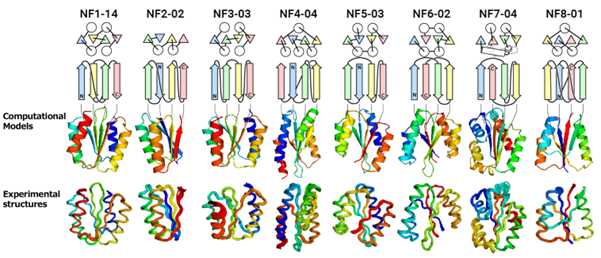Beyond nature’s imagination: Scientists discover extensive array of protein folds unexplored in nature
- Press Release
Summary:
A research team has discovered an astounding array of unexplored protein folds. This research will expand our understanding of the depth of the protein universe and the possibilities for de novo design of functional proteins.
Full Text:
Osaka, Japan — A groundbreaking study has shed new light on the astonishing diversity of protein structures and their folds in nature. Researchers set out to reveal the extent to which nature has explored the vast landscape of possible protein topologies. The results have unveiled an astounding array of unexplored protein folds, expanding our understanding and uncovering the depth of the protein universe.
This research has been published in the journal Nature Structural and Molecular Biology on July 3, 2023.
Proteins, the building blocks of life, fold into specific three-dimensional structures, enabling them to carry out their biological functions. The three-dimensional structures of proteins are dictated by their amino acid sequences. While experimental techniques have successfully unraveled the structures of numerous proteins over the years, the discovery of new protein folds, defined by the arrangement and connectivity of α-helices and β-strands, has become increasingly infrequent. This raises the question: how extensive is the protein fold space not explored by nature? Although theoretical studies have been conducted to address this question, experimental validation has been lacking.
To address this, the research team embarked on a study combining theoretical prediction of novel protein folds with experimental validation of their de novo designs.
The researchers devised rules based on physical chemistry and protein structure data to predict possible protein folds. These rules were used to predict novel αβ-folds—structures composed of four to eight stranded β-sheets not yet observed in the Protein Data Bank (PDB). This led to the identification of 12,356 novel folds. The team then computationally designed proteins for these folds to test their foldability and structural fidelity.
“We attempted to computationally design proteins with all of the predicted folds that have a four-stranded β-sheet, including one forming a knot-like structure,” said Shintaro Minami (ExCELLS). “When designing proteins, we did not expect all of them, especially knot-forming ones, to fold into the structures as anticipated.”
The results were surprising. “For all of the folds, the computationally designed protein structures closely matched the experimental structures,” said Naohiro Kobayashi (RIKEN).
These findings suggest the existence of at least 10,000 unexplored foldable αβ-folds — a major revelation, given that only about 400 αβ-folds have been observed in nature. This implies that many potential protein folds remain uncharted.
Several hypotheses arise from these results. One is that proteins may not have existed long enough in biology to explore all possible folds. Another is that natural protein folds are inherently biased due to all life on Earth having a common ancestor. “Proteins may have evolved by repeatedly reusing specific folds while expressing different functions. If extraterrestrial life exists, it might be utilizing a different set of protein folds,” said George Chikenji (Nagoya University).
Since protein functions are determined by their diverse 3D structures, this study opens the door to expanding that diversity. “Designing proteins with these novel folds will lead to the creation of new structures, enabling breakthroughs in drug development, enzyme engineering, and beyond,” said Nobuyasu Koga (ExCELLS, NINS).
Figure

Image License & Credit
- License: CC BY
- Usage restriction: CC BY
- Credit: 2023, Nobuyasu Koga, Exploration of novel αβ-protein folds through de novo design, Nature Structural and Molecular Biology
Publication Details
- Title: Exploration of novel αβ-protein folds through de novo design
- Journal: Nature Structural and Molecular Biology
- Authors: Shintaro Minami, Naohiro Kobayashi, Toshihiko Sugiki, Toshio Nagashima, Toshimichi Fujiwara, Rie Tatsumi-Koga, George Chikenji, Nobuyasu Koga
- DOI: s41594-023-01029-0
- Funded by: Japan Society for the Promotion of Science; Japan Agency for Medical Research and Development; Astrobiology Center Program of NINS; JST-Mirai Program
